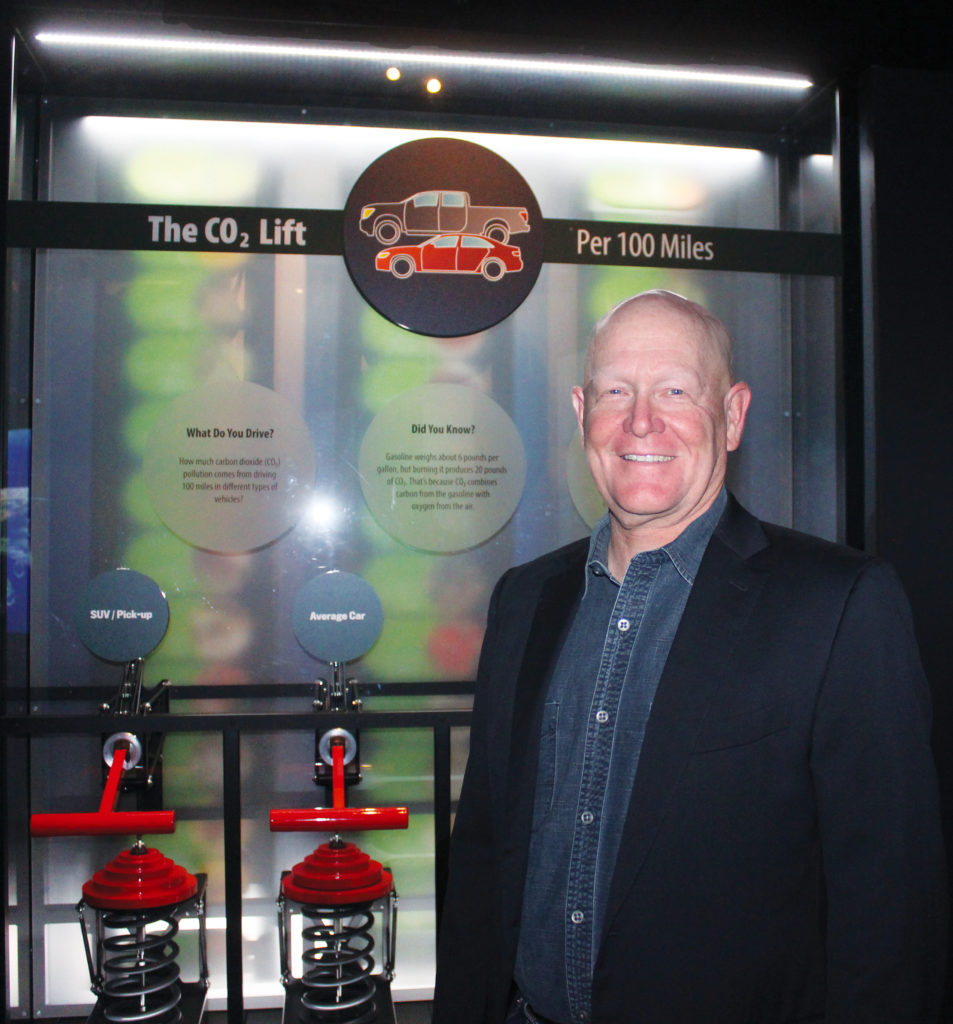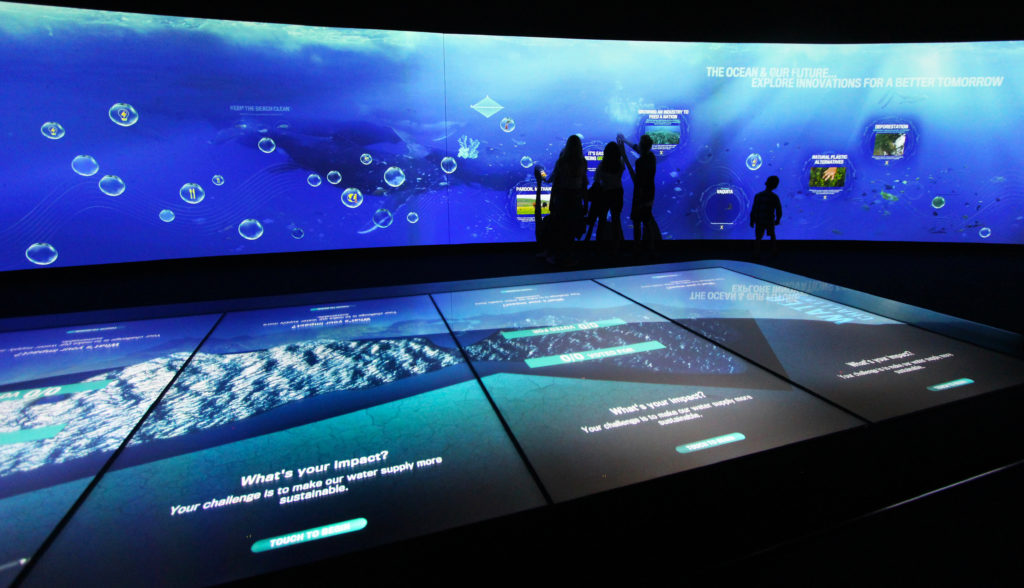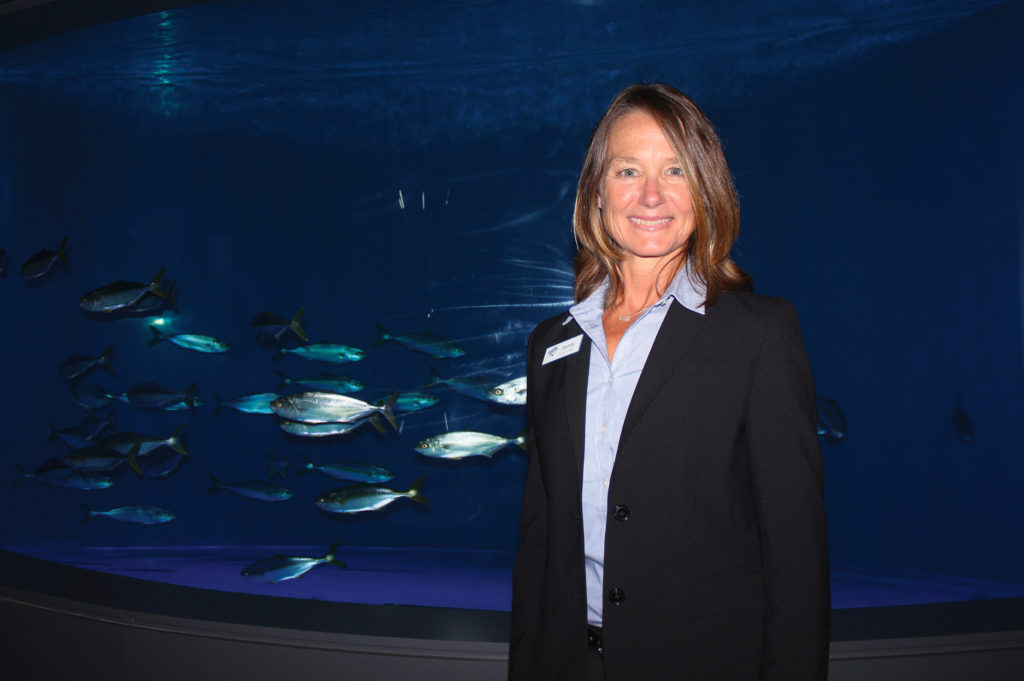As its name implies, the culmination gallery is the final stop of the Aquarium’s Pacific Visions wing. “It is called the culmination gallery because it meant to be the culmination of the whole Pacific Visions experience,” Director of Pacific Visions and Architecture Fahria Qader told the Business Journal. “It is the place where people, after learning about . . . the future, will get to connect it to their lives through their choices and build the future we want to live in.”
Visitors enter the culmination gallery from the Honda Pacific Visions Theater, where the film “Designing Our Future” explains the challenges of the planet’s growing population. The short feature focuses on three essential resources – food, water and energy – and the potential of the ocean to produce all three. In the culmination gallery, guests interact with exhibits that build on the themes of the film in entertaining and educational ways. The gallery was designed by the Aquarium in collaboration with media company Cortina Productions and Tom Bowman, founder and CEO of Bowman Change, Inc., a design consultancy firm.

“Tom has been working with us for quite a few years, and he’s designed a lot of our changing exhibits,” Qader explained. “We started with him and [by] talking with a lot of experts in the field [as well as] scientists, gathering information from them on what they would like the public to know.”
After exiting the theater, the first exhibit that guests encounter is a tall, triangular column that Qader referred to as the population tower. Users can guess how the populations of California and the world are projected to grow by 2050 and enter a figure into a panel. The tower then pulls real-time data on population and resource consumption from the United Nations Population Division, the World Health Organization, the International Monetary Fund and World Bank, and displays the information.
“It’s a cool thing to do, but the scale of it lets you know something important about the growth of population,” Bowman said. “We don’t want to bury that on a 13-inch monitor on a tabletop, because then you have to stop and think, ‘Am I going to read that? Does it sink in?’ Well, it’s definitely going to sink in when it’s a tower of lights.”
These are the type of aesthetic and educational concerns that Bowman and the Aquarium discussed when designing the gallery. “It’s a combination of all the tools of good design and thinking through what the content priorities are – and how to express them so that everybody is impressed by them,” Bowman explained.
The next eye-catching exhibit visitors encounter is the 50-foot-long media wall designed by Cortina Productions. “It shows this beautiful scenery underwater, and then you have all of these bubbles flowing through,” Qader said. The digital bubbles pop when touched, and facts, videos or images of animals spring out. The content of the bubble varies by height, with simpler information for children accessible near the bottom of the wall and more detailed information floating above.
Three interactive tables located in the center of the gallery ask visitors to answer questions about food, water and energy. “They’re all focused on California,” Bowman explained. “The great water game: how will we ensure California has enough water in the future? The energy game: how will we make sure there’s enough electricity in California that is low in carbon emissions or free of carbon emissions? And the great food game: what happens to agriculture [and] how do we increase production of agriculture in a changing climate?”
The goal of the game is to make sure there’s enough food, water and clean energy to sustain the population in 2050. Each table hosts 10 people at a time, for a maximum of 30 total players. After answering all the questions, the players discover whether or not they’ve allocated enough resources for everyone. “The underlying message is that the future is something we’ll create together; the future will be the net of all the choices that we make,” Bowman said.

Other exhibits in the gallery include a machine that invites visitors to test the weight of carbon emissions from various vehicles and a virtual tour of a future sustainable city.
This interactive gallery is a far cry from traditional aquarium exhibits, which typically only feature tanks with live marine creatures. “As Jerry [Schubel], our CEO, likes to say, we want to be the aquarium of the future,” Qader said. “We don’t want to be just an aquarium. We want to be a combination of an art museum, a science museum, a natural history museum, a community gathering place, a place where scientists come and discuss important matters.”
The culmination gallery does feature three animal exhibits, which highlight the themes of food, water and energy sustainability. The first displays a tiny yet notorious fish that lives only in the Sacramento-San Joaquin River Delta. The delta smelt is critically endangered due to human development and diversion of its fresh water habitat. “It’s been portrayed as this evil little fish because it keeps Californians from taking more water out of the delta for agriculture and urban use,” Jerry Schubel, Aquarium president and CEO, said.
The exhibit showcasing delta smelt highlights the delicate balance between humans and the natural ecosystem. It is the first time that delta smelt have been publicly exhibited in an aquarium, according to Schubel. “We try to make the argument [that] it’s not about fish versus farmers; it’s about humans learning to share water with nature,” he explained.
About two-thirds of Californians get their water from the delta, Schubel said. Diverting fresh water from the smelt’s habitat, combined with predation from invasive species, has reduced the species’ population to near extinction. Only one specimen was found during a 2016 survey of the delta, according to the Aquarium’s fact sheet. Zero delta smelt were found in a 2018 survey. “We included the delta smelt because it can be seen as an indicator of our commitment to sharing water with nature,” Schubel said. “Unfortunately, nature usually ‘bats last’ when allocations of freshwater are made.”
The other two animal exhibits in the culmination gallery focus on marine aquaculture, according to Dr. Sandy Trautwein, vice president of husbandry at the Aquarium. One tank holds yellowtail jack, a popular sport fish of Southern California. Trautwein said the fish are a great candidate for marine aquaculture farms. They supply a rich and abundant source of protein and, unlike cattle, require no diversion of fresh water and contribute less methane to the atmosphere.

Two species of oysters are also on display: the Pacific oyster, primarily grown for food, and the Olympia oyster, which is native to the coast of California and protects the shoreline from contamination and erosion. “They’re feeding on the plankton and other microorganisms in the water that help to keep our waterways clear and clean and healthy so that things like eel grass can grow and survive,” Trautwein said. “They also protect the shorelines from storm surge because they are a hard substrate that protects the softer substrates from washing away.” That hard substrate also provides an excellent habitat for small species of fish and snails that are essential to a healthy coastal ecosystem, she added.
With its animal displays, interactive games and focus on the future, the culmination gallery was designed as a place of playful learning, Bowman said. “What we designed for is to keep that sense of hope and fun really front and center in these exhibits, so that you learn and feel motivated to learn, and feel inspired.”
Throughout his career, Bowman has worked with many organizations, museums and academic institutions on environmental topics. Science museums and aquariums have traditionally taken scientific information and distilled it for public consumption, Bowman explained. What is unfortunate, he noted, is that there is no companion institution to offer suggestions for how this science should be applied to address the leading issues of the day. “I give a lot of credit to the Aquarium for taking this bold step, beyond just telling us about the science but actually beginning the conversation.”
